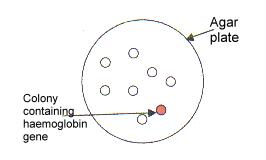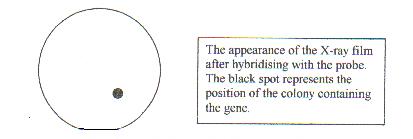| Question: What is meant by "Southern Blotting"? |
|
|
|
Answer: The Southern blotting technique
is a technique that enables specific sequences of DNA, or specific
genes to be identified. It is essentially a way of transferring
DNA onto nitrocellulose membrane. There are several uses:-  (b) The mRNA is converted into copy DNA using an enzyme called reverse transcriptase. This means that all the mRNA is now in the form of DNA.  (c)The DNA is placed into plasmid vectors and these inserted into bacteria, usually E.coli. Since there will be thousands of genes placed into the plasmids and each bacteria will carry one, it is difficult to identify the bacterial colony that carries the haemoglobin gene. This is where Southern blotting comes in. The bacteria are plated onto nutrient agar and allowed to grow into colonies:-  A piece of material called a nitrocellulose membrane is laid onto the plate. This picks up some of the colonies and fixes the DNA from them onto it. The colony containing the haemoglobin plasmid is now identified by using a radiolabelled DNA probe with a sequence complementary to the human gene, the rat gene would be used since it will have a close enough similarity, it is labelled with 32P- phosphate or 35S sulphur to make it radioactive. The probe will only stick to the nitrocellulose where the haemoglobin gene is, so after hybridising, the membrane is placed next to X-ray film to identify the location of the bacteria that contain the gene.  The correct colony can now be "grown up" to produce large numbers of the human gene. The gene has now been cloned. (2) Southern blotting can also be used to detect sequences of DNA in organisms' genomes. Here the DNA is extracted and digested using a variety of restriction endonucleases and the DNA separated on the basis of size using gel electrophoresis. This gel is taken and the DNA transferred onto nitrocellulose membrane by Southern blotting. The blot can now be hybridised with a variety of radiolabelled probes to identify the presence of certain genes, or to identify sequences that are specific to individuals - in other words DNA fingerprinting. These techniques are useful in the diagnosis of genetic disease, and useful in identification of individuals in crimes or paternity suits! |
|
|